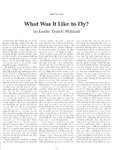My favourite aircraft of WWII (and probably of all time) is the DH.98 Mosquito - if I had a sig on here it would be one of those. But there's one question about it that's been niggling me for a while - it was often referred to as having difficult landing characteristics.
I have read some comments re. light aileron control at low speeds and a high landing speed, but there's a couple of things which have brought this into focus. I have read on PPRUNE that the Mosquito had landing characteristics which wouldn't be tolerated in modern aircraft (though that would apply to a lot of WWII planes), and I have a vague recollection of reading an account of a Mossie pilots log-book where he crashed on landing and only wrote 'Don't want to fly Mossies no more'.
The Beaufighter swing on take-off is often referred to, but the Mosquito's landing problems seem to be brushed over.
So, my question is what were the Mosquito's problems on approach and landing, and were they particularly severe?
I have read some comments re. light aileron control at low speeds and a high landing speed, but there's a couple of things which have brought this into focus. I have read on PPRUNE that the Mosquito had landing characteristics which wouldn't be tolerated in modern aircraft (though that would apply to a lot of WWII planes), and I have a vague recollection of reading an account of a Mossie pilots log-book where he crashed on landing and only wrote 'Don't want to fly Mossies no more'.
The Beaufighter swing on take-off is often referred to, but the Mosquito's landing problems seem to be brushed over.
So, my question is what were the Mosquito's problems on approach and landing, and were they particularly severe?



